Quantifying Phosphorus Leaching Loss from Mollisol with Organic Amendments
Abstract
:1. Introduction
2. Materials and Methods
2.1. Study Site and Experimental Design
2.2. Collection of Leachate Samples
2.3. Analysis of Leachate Samples
2.4. Statistical Analysis
3. Results
3.1. Seasonal Variations in Soil Surface Temperature, Rainfall, and Soil Water Leaching
3.2. Seasonal Variations in P Leaching in Various Forms
3.3. Cumulative Leaching Loss of Each P Form in Mollisol
3.4. Canonical Discriminant Analysis of Management Practices towards P Leaching Loss
3.5. Relationship between P Leaching Loss and Environmental Factors
4. Discussion
4.1. Water Leaching in Mollisol
4.2. P Leaching in Various Forms from Mollisol with Organic Amendments
4.3. Relationship between P Leaching and Environmental Factors
5. Conclusions
Author Contributions
Funding
Data Availability Statement
Acknowledgments
Conflicts of Interest
References
- Jiao, Y.; Whalen, J.K.; Hendershot, W.H. Phosphate Sorption and Release in a Sandy-Loam Soil as Influenced by Fertilizer Sources. Soil Sci. Soc. Am. J. 2007, 71, 118–124. [Google Scholar] [CrossRef] [Green Version]
- Xi, B.; Zhai, L.; Liu, S.; Liu, H.; Yang, B.; Ren, T. Effects of Combination of Organic and Inorganic Fertilization on Maize Yield and Soil Nitrogen and Phosphorus Leaching. J. Plant Nutr. Fertil. 2015, 21, 326–335. [Google Scholar]
- Huang, R.; Gao, X.; Wang, F.; Xu, G.; Long, Y.; Wang, C.; Wang, Z.; Gao, M. Effects of Biochar Incorporation and Fertilizations on Nitrogen and Phosphorus Losses through Surface and Subsurface Flows in a Sloping Farmland of Entisol. Agric. Ecosyst. Environ. 2020, 300, 106988. [Google Scholar] [CrossRef]
- Liu, G.; Deng, L.; Wu, R.; Guo, S.; Du, W.; Yang, M.; Bian, J.; Liu, Y.; Li, B.; Chen, F. Determination of Nitrogen and Phosphorus Fertilisation Rates for Tobacco Based on Economic Response and Nutrient Concentrations in Local Stream Water. Agric. Ecosyst. Environ. 2020, 304, 107136. [Google Scholar] [CrossRef]
- Wei, K.; Bao, H.; Huang, S.; Chen, L. Effects of Long-Term Fertilization on Available P, P Composition and Phosphatase Activities in Soil from the Huang-Huai-Hai Plain of China. Agric. Ecosyst. Environ. 2017, 237, 134–142. [Google Scholar] [CrossRef]
- Abrar, M.M.; Xu, H.; Aziz, T.; Sun, N.; Mustafa, A.; Aslam, M.W.; Shah, S.A.A.; Mehmood, K.; Zhou, B.; Ma, X.; et al. Carbon, Nitrogen, and Phosphorus Stoichiometry Mediate Sensitivity of Carbon Stabilization Mechanisms along with Surface Layers of a Mollisol after Long-Term Fertilization in Northeast China. J. Soils Sediments 2021, 21, 705–723. [Google Scholar] [CrossRef]
- Jobbagy, E.G.; Jackson, R.B. The Distribution of Soil Nutrients with Depth: Global Patterns and the Imprint of Plants. Biogeochemistry 2001, 53, 51–77. [Google Scholar] [CrossRef]
- Sui, Y.; Thompson, M.L.; Mize, C.W. Redistribution of Biosolids-Derived Total Phosphorus Applied to a Mollisol. J. Environ. Qual. 1999, 28, 1068–1074. [Google Scholar] [CrossRef]
- Grenon, G.; Singh, B.; de Sena, A.; Madramootoo, C.A.; von Sperber, C.; Goyal, M.K.; Zhang, T. Phosphorus Fate, Transport and Management on Subsurface Drained Agricultural Organic Soils: A Review. Environ. Res. Lett. 2021, 16, 013004. [Google Scholar] [CrossRef]
- Ji, W.; Yokoyama, H.; Fu, J.; Zhou, J. Effects of Intensive Fish Farming on Sediments of a Temperate Bay Characterised by Polyculture and Strong Currents. Aquac. Rep. 2021, 19, 100579. [Google Scholar] [CrossRef]
- Leinweber, P.; Bathmann, U.; Buczko, U.; Douhaire, C.; Eichler-Löbermann, B.; Frossard, E.; Ekardt, F.; Jarvie, H.; Krämer, I.; Kabbe, C.; et al. Handling the Phosphorus Paradox in Agriculture and Natural Ecosystems: Scarcity, Necessity, and Burden of P. Ambio 2018, 47, 3–19. [Google Scholar] [CrossRef]
- Masto, R.E.; Chhonkar, P.K.; Singh, D.; Patra, A.K. Alternative Soil Quality Indices for Evaluating the Effect of Intensive Cropping, Fertilisation and Manuring for 31 Years in the Semi-Arid Soils of India. Environ. Monit. Assess. 2008, 136, 419–435. [Google Scholar] [CrossRef]
- Giles, C.D.; Cade-Menun, B.J.; Liu, C.W.; Hill, J.E. The Short-Term Transport and Transformation of Phosphorus Species in a Saturated Soil Following Poultry Manure Amendment and Leaching. Geoderma 2015, 257–258, 134–141. [Google Scholar] [CrossRef] [Green Version]
- Khan, A.; Lu, G.; Ayaz, M.; Zhang, H.; Wang, R.; Lv, F.; Yang, X.; Sun, B.; Zhang, S. Phosphorus Efficiency, Soil Phosphorus Dynamics and Critical Phosphorus Level under Long-Term Fertilization for Single and Double Cropping Systems. Agric. Ecosyst. Environ. 2018, 256, 1–11. [Google Scholar] [CrossRef]
- Schoumans, O.F. Phosphorus Leaching from Soils: Process Description, Risk Assessment and Mitigation. Ph.D. Thesis, Wageningen University and Research, Wageningen, The Netherlands, 2015. [Google Scholar]
- Allen, S.C.; Nair, V.D.; Graetz, D.A.; Jose, S.; Ramachandran Nair, P.K. Phosphorus Loss from Organic versus Inorganic Fertilizers Used in Alleycropping on a Florida Ultisol. Agric. Ecosyst. Environ. 2006, 117, 290–298. [Google Scholar] [CrossRef]
- Vanden Nest, T.; Vandecasteele, B.; Ruysschaert, G.; Cougnon, M.; Merckx, R.; Reheul, D. Effect of Organic and Mineral Fertilizers on Soil P and C Levels, Crop Yield and P Leaching in a Long Term Trial on a Silt Loam Soil. Agric. Ecosyst. Environ. 2014, 197, 309–317. [Google Scholar] [CrossRef] [Green Version]
- Qu, Y.; Pan, C. Factors Affecting the Promotion of Conservation Tillage in Black Soil—The Case of Northeast China. Sustainability 2021, 13, 9596. [Google Scholar] [CrossRef]
- Fan, R.; Zhang, B.; Li, J.; Zhang, Z.; Liang, A. Straw-Derived Biochar Mitigates CO2 Emission through Changes in Soil Pore Structure in a Wheat-Rice Rotation System. Chemosphere 2020, 243, 125329. [Google Scholar] [CrossRef]
- Jalali, M.; Jalali, M. Assessment Risk of Phosphorus Leaching from Calcareous Soils Using Soil Test Phosphorus. Chemosphere 2017, 171, 106–117. [Google Scholar] [CrossRef]
- Mcdowell, R.W.; Worth, W.; Carrick, S. Evidence for the Leaching of Dissolved Organic Phosphorus to Depth. Sci. Total Environ. 2021, 755, 142392. [Google Scholar] [CrossRef]
- Pizzeghello, D.; Schiavon, M.; Maretto, L.; Stevanato, P.; Ertani, A.; Altissimo, A.; Nardi, S. Short-Term Application of Polymer-Coated Mono-Ammonium Phosphate in a Calcareous Soil Affects the Pools of Available Phosphorus and the Growth of Hypericum × moserianum (L.). Front. Sustain. Food Syst. 2019, 3, 4. [Google Scholar] [CrossRef]
- Li, X.; Guo, M.; Duan, X.; Zhao, J.; Hua, Y.; Zhou, Y.; Liu, G.; Dionysiou, D.D. Distribution of Organic Phosphorus Species in Sediment Profiles of Shallow Lakes and Its Effect on Photo-Release of Phosphate during Sediment Resuspension. Environ. Int. 2019, 130, 104916. [Google Scholar] [CrossRef]
- Jiang, X.; Livi, K.J.; Arenberg, M.R.; Chen, A.; Chen, K.Y.; Gentry, L.; Li, Z.; Xu, S.; Arai, Y. High Flow Event Induced the Subsurface Transport of Particulate Phosphorus and Its Speciation in Agricultural Tile Drainage System. Chemosphere 2021, 263, 128147. [Google Scholar] [CrossRef]
- McDowell, R.W.; Sharpley, A.N. Phosphorus Losses in Subsurface Flow before and after Manure Application to Intensively Farmed Land. Sci. Total Environ. 2001, 278, 113–125. [Google Scholar] [CrossRef]
- Jensen, M.B.; Olsen, T.B.; Hansen, H.C.B.; Magid, J. Dissolved and Particulate Phosphorus in Leachate from Structured Soil Amended with Fresh Cattle Faeces. Nutr. Cycl. Agroecosystems 2000, 56, 253–261. [Google Scholar] [CrossRef]
- McGechan, M.B.; Hooda, P.S. Modelling Water Pollution by Leached Soluble Phosphorus, Part 1: Calibration of the ANIMO Model. Biosyst. Eng. 2010, 106, 138–146. [Google Scholar] [CrossRef]
- Qu, Y.; Wang, C.; Guo, J.; Huang, J.; Fang, F.; Xiao, Y.; Ouyang, W.; Lu, L. Characteristics of Organic Phosphorus Fractions in Soil from Water-Level Fluctuation Zone by Solution 31P-Nuclear Magnetic Resonance and Enzymatic Hydrolysis. Environ. Pollut. 2019, 255, 113209. [Google Scholar] [CrossRef]
- Penn, C.; Livingston, S.; Shedekar, V.; King, K.; Williams, M. Performance of Field-Scale Phosphorus Removal Structures Utilizing Steel Slag for Treatment of Subsurface Drainage. Water 2020, 12, 443. [Google Scholar] [CrossRef] [Green Version]
- Hull, D.K.; Ruttenberg, K.C. Dissolved Organic Phosphorus Molecular Weight Fractionation and Apparent Bioavailability Quantified via Coupled Sequential Ultrafiltration and Enzyme Hydrolysis. Limnol. Oceanogr. Methods 2022, 20, 467–481. [Google Scholar] [CrossRef]
- Yang, C.; Lu, S. Straw and Straw Biochar Differently Affect Phosphorus Availability, Enzyme Activity and Microbial Functional Genes in an Ultisol. Sci. Total Environ. 2022, 805, 150325. [Google Scholar] [CrossRef]
- Heal, M.R.; Dickey, C.A.; Heal, K.V.; Stidson, R.T.; Matucha, M.; Cape, J.N. The Production and Degradation of Trichloroacetic Acid in Soil: Results from in Situ Soil Column Experiments. Chemosphere 2010, 79, 401–407. [Google Scholar] [CrossRef]
- Standard Methods for the Examination of Water and Wastewater, 23rd ed.; American Public Health Association: Washington, DC, USA; American Water Works Association: Denver, CO, USA; Water Environment Federation: Washington, DC, USA, 1998.
- Shen, Q.; Wang, X.; Qu, F.; Xiao, Z.; Zhang, X.; Zhang, S. Responses of Soil Total Phosphorus to Freeze and Thaw Cycles in a Mollisol Watershed. Geoderma 2020, 376, 114571. [Google Scholar] [CrossRef]
- Ruan, R.; Zhang, Z.; Wang, Y.; Guo, Z.; Zhou, H.; Tu, R.; Hua, K.; Wang, D.; Peng, X. Long-Term Straw Rather than Manure Additions Improved Least Limiting Water Range in a Vertisol. Agric. Water Manag. 2022, 261, 107356. [Google Scholar] [CrossRef]
- Rashmi, I.; Biswas, A.K.; Kartika, K.S.; Kala, S. Phosphorus Leaching through Column Study to Evaluate P Movement and Vertical Distribution in Black, Red and Alluvial Soils of India. J. Saudi Soc. Agric. Sci. 2020, 19, 241–248. [Google Scholar] [CrossRef]
- Pizzeghello, D.; Berti, A.; Nardi, S.; Morari, F. Phosphorus-related properties in the profiles of three Italian soils after long-term mineral and manure applications. Agric. Ecosyst. Environ. 2014, 189, 216–228. [Google Scholar] [CrossRef]
- Pizzeghello, D.; Berti, A.; Nardi, S.; Morari, F. Relationship between soil test phosphorus and phosphorus release to solution in three soils after long-term mineral and manure application. Agric. Ecosyst. Environ. 2016, 233, 214–223. [Google Scholar] [CrossRef]
- Dixon, M.; Simonne, E.; Obreza, T.; Liu, G. Crop Response to Low Phosphorus Bioavailability with a Focus on Tomato. Agronomy 2020, 10, 617. [Google Scholar] [CrossRef]
- Pizzeghello, D.; Berti, A.; Nardi, S.; Morari, F. Phosphorus forms and P-sorption properties in three alkaline soils after long-term mineral and manure applications in north-eastern Italy. Agric. Ecosyst. Environ. 2011, 141, 58–66. [Google Scholar] [CrossRef]
- Joan, R.; José Manuel, B.M.; Xavier, S.F. Phosphorus Mobilization in Low-P Arable Soils May Involve Soil Organic C Depletion. Soil Biol. Biochem. 2017, 113, 250–259. [Google Scholar]
- Rao, D.N.; Mikkelsen, D.S. Effect of Rice Straw Additions on Production of Organic Acids in a Flooded Soil. Plant Soil 1977, 47, 303–311. [Google Scholar] [CrossRef]
- Žifčáková, L.; Větrovský, T.; Howe, A.; Baldrian, P. Microbial Activity in Forest Soil Reflects the Changes in Ecosystem Properties between Summer and Winter. Environ. Microbiol. 2016, 18, 288–301. [Google Scholar] [CrossRef] [Green Version]
- Aoyama, M.; Angers, D.A.; Dayegamiye, A.N. Particulate and Mineral-Associated Organic Matter in Water-Stable Aggregates as Affected by Mineral Fertilizer and Manure Applications. Can. J. Soil Sci. 1999, 79, 295–302. [Google Scholar] [CrossRef]
- Kwaad, F.J.P. Summer and Winter Regimes of Runoff Generation and Soil Erosion on Cultivated Loess Soils (The Netherlands). Earth Surf. Process. Landforms 1991, 16, 653–662. [Google Scholar] [CrossRef]
- Chen, J.; Yang, L.; Chen, X.; Ripp, S.; Radosevich, M.; Zhuang, J. Bacterial Mobility Facilitated by Soil Depth and Intact Structure. Soil Tillage Res. 2021, 209, 104911. [Google Scholar] [CrossRef]
- Liu, J.; Bi, X.; Ma, M.; Jiang, L.; Du, L.; Li, S.; Sun, Q.; Zou, G.; Liu, H. Precipitation and Irrigation Dominate Soil Water Leaching in Cropland in Northern China. Agric. Water Manag. 2019, 211, 165–171. [Google Scholar] [CrossRef]
- Schreiber, J.D.; Mc Dowell, L.L. Leaching of Nitrogen, Phosphorus, and Organic Carbon From Wheat Straw Residues: II. Loading Rate. J. Environ. Qual. 1985, 14, 256–260. [Google Scholar] [CrossRef]
- Sims, J.T.; Simard, R.R.; Joern, B.C. Phosphorus Loss in Agricultural Drainage: Historical Perspective and Current Research. J. Environ. Qual. 1998, 27, 277–293. [Google Scholar] [CrossRef] [Green Version]
- Xu, L.G.; Zhang, Q.; Xu, J.; Jiang, H.; Huang, L. Migration and Leaching Losses of Nutrients in Relation to Rainfall Intensity. Acta Pedol. Sin. 2008, 45, 437–443. [Google Scholar]
- Li, X.; Zhang, W.; Wu, J.; Li, H.; Zhao, T.; Zhao, C.; Shi, R.; Li, Z.; Wang, C.; Li, C. Loss of Nitrogen and Phosphorus from Farmland Runoff and the Interception Effect of an Ecological Drainage Ditch in the North China Plain—A Field Study in a Modern Agricultural Park. Ecol. Eng. 2021, 169, 106310. [Google Scholar] [CrossRef]
- Han, Y.; Choi, B.; Chen, X. Adsorption and Desorption of Phosphorus in Biochar-Amended Black Soil as Affected by Freeze-Thaw Cycles in Northeast China. Sustainability 2018, 10, 1574. [Google Scholar] [CrossRef] [Green Version]
- Orem, W.; Newman, S.; Osborne, T.Z.; Reddy, K.R. Projecting Changes in Everglades Soil Biogeochemistry for Carbon and Other Key Elements, to Possible 2060 Climate and Hydrologic Scenarios. Environ. Manag. 2015, 55, 776–798. [Google Scholar] [CrossRef]
- Gao, L.; Becker, E.; Liang, G.; Houssou, A.A.; Wu, H.; Wu, X.; Cai, D.; Degré, A. Effect of Different Tillage Systems on Aggregate Structure and Inner Distribution of Organic Carbon. Geoderma 2017, 288, 97–104. [Google Scholar] [CrossRef]
- Zhao, Y.; Li, Y.; Yang, F. Critical Review on Soil Phosphorus Migration and Transformation under Freezing-Thawing Cycles and Typical Regulatory Measurements. Sci. Total Environ. 2021, 751, 141614. [Google Scholar] [CrossRef]
- Kianpoor Kalkhajeh, Y.; Huang, B.; Hu, W. The Relation of Preferential Flow Pathways to Phosphorus Leaching from Typical Plastic Shed Vegetable Production Soils of China. Agric. Ecosyst. Environ. 2021, 307, 107218. [Google Scholar] [CrossRef]
- Svanbäck, A.; Ulén, B.; Etana, A. Mitigation of Phosphorus Leaching Losses via Subsurface Drains from a Cracking Marine Clay Soil. Agric. Ecosyst. Environ. 2014, 184, 124–134. [Google Scholar] [CrossRef]
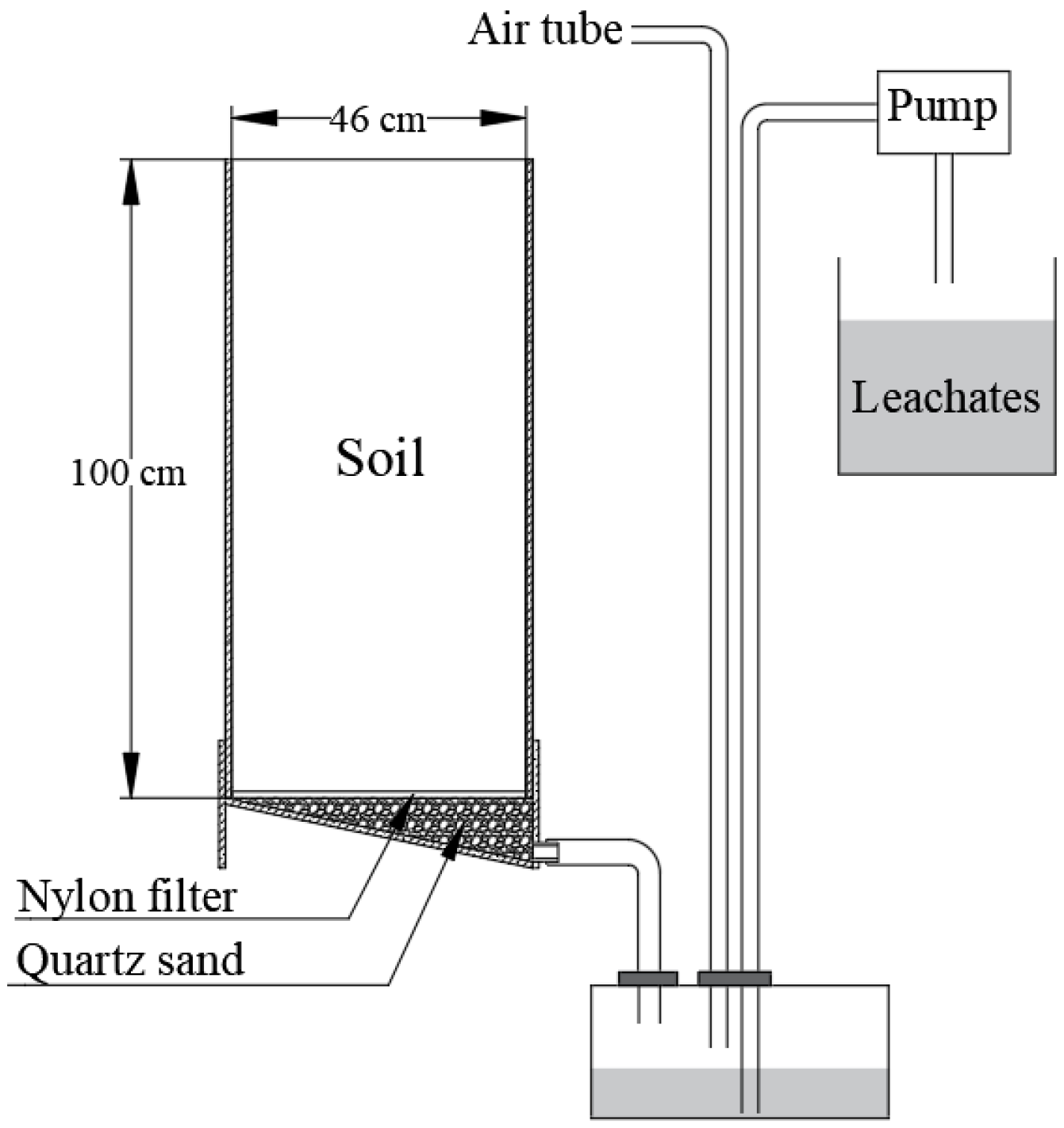
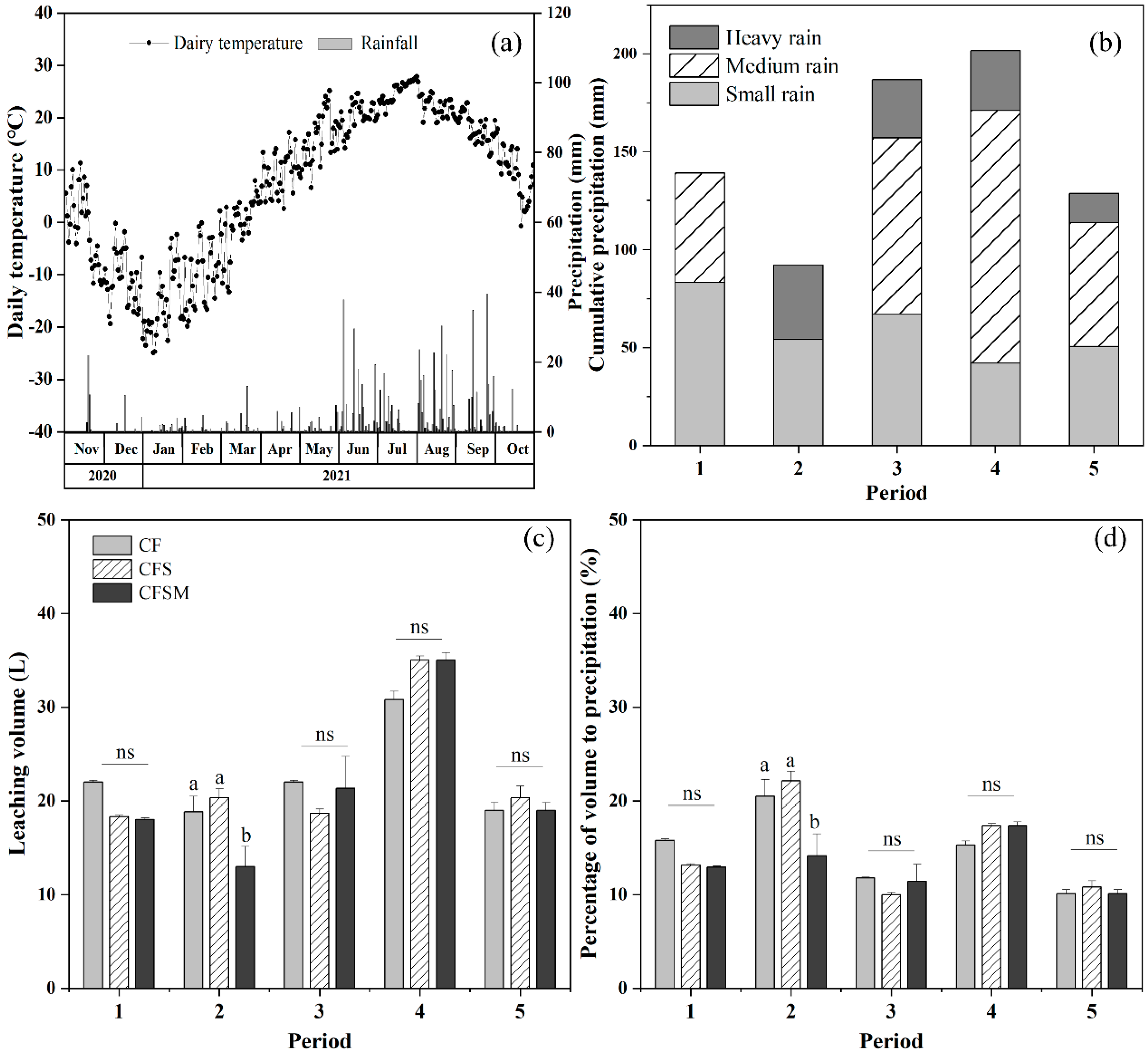

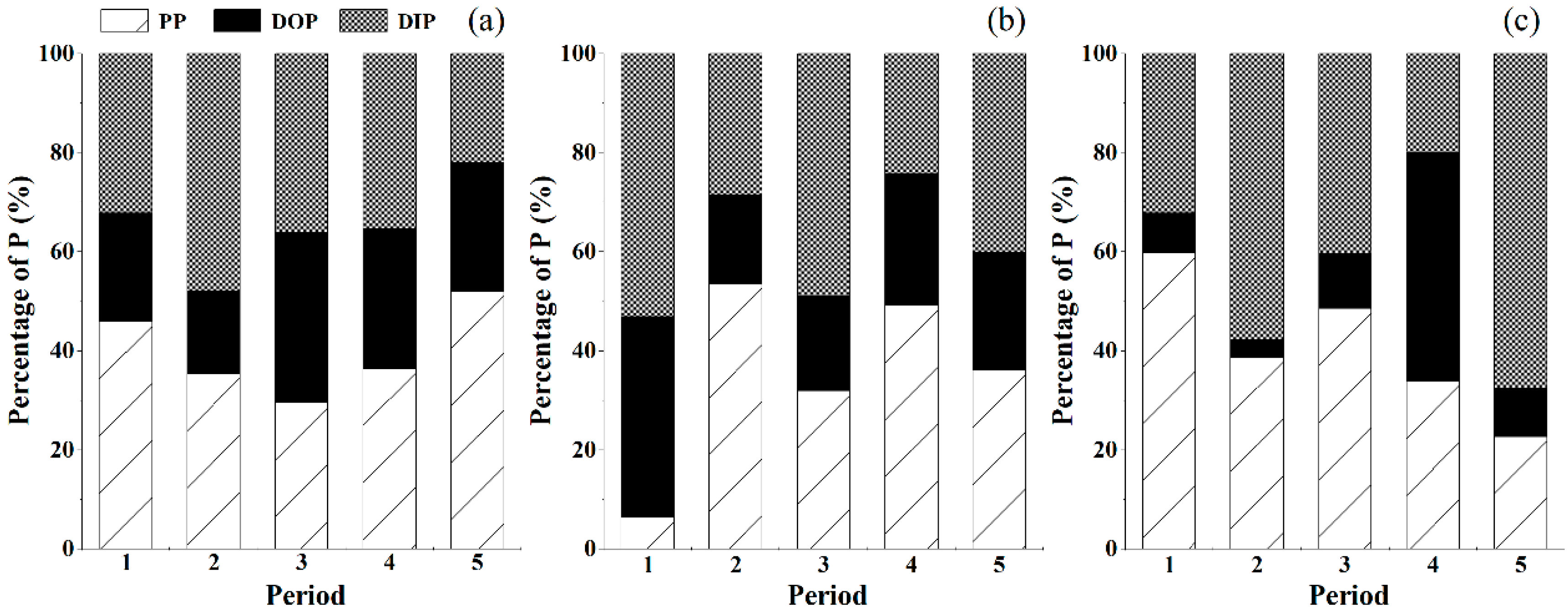
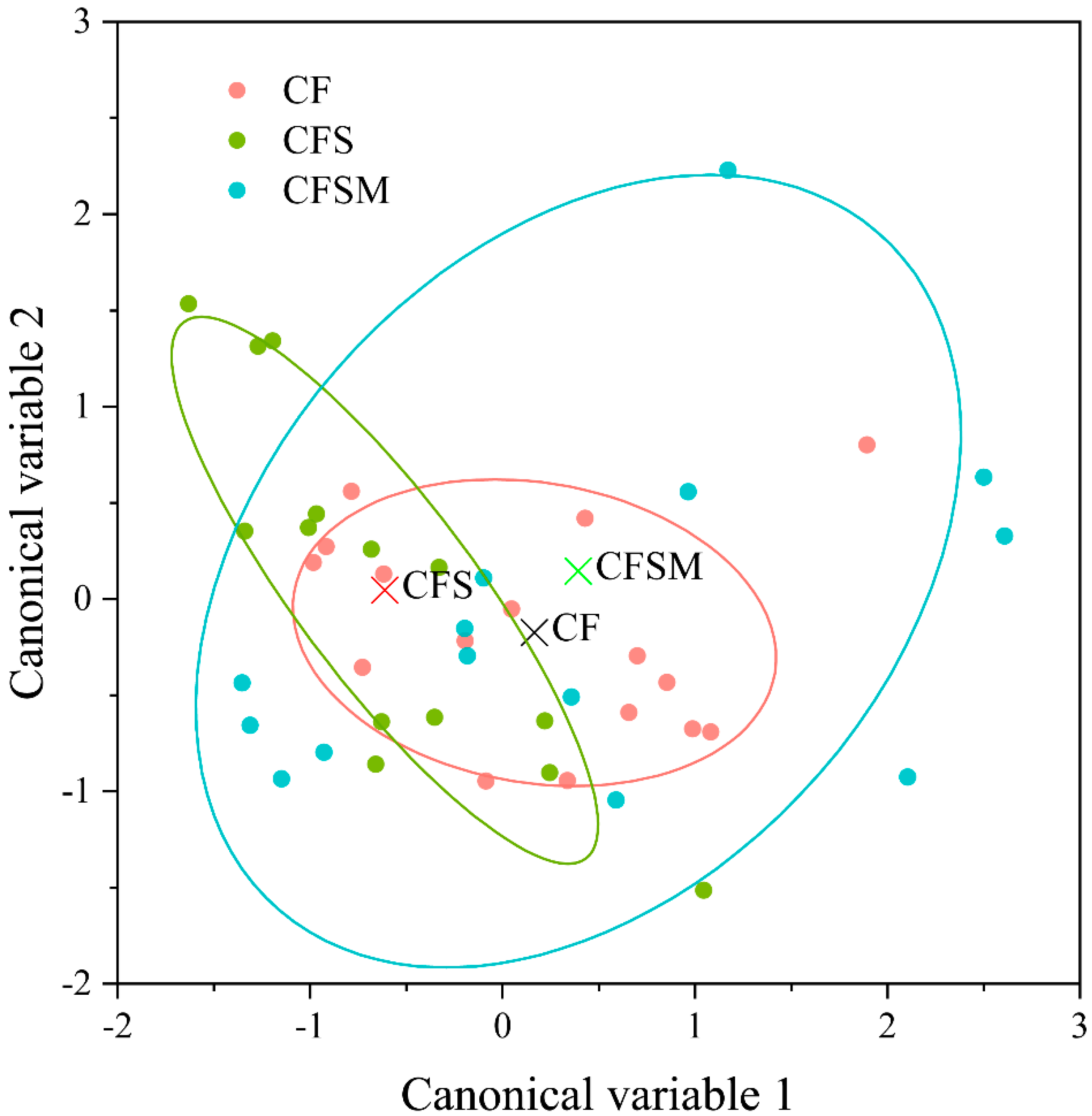
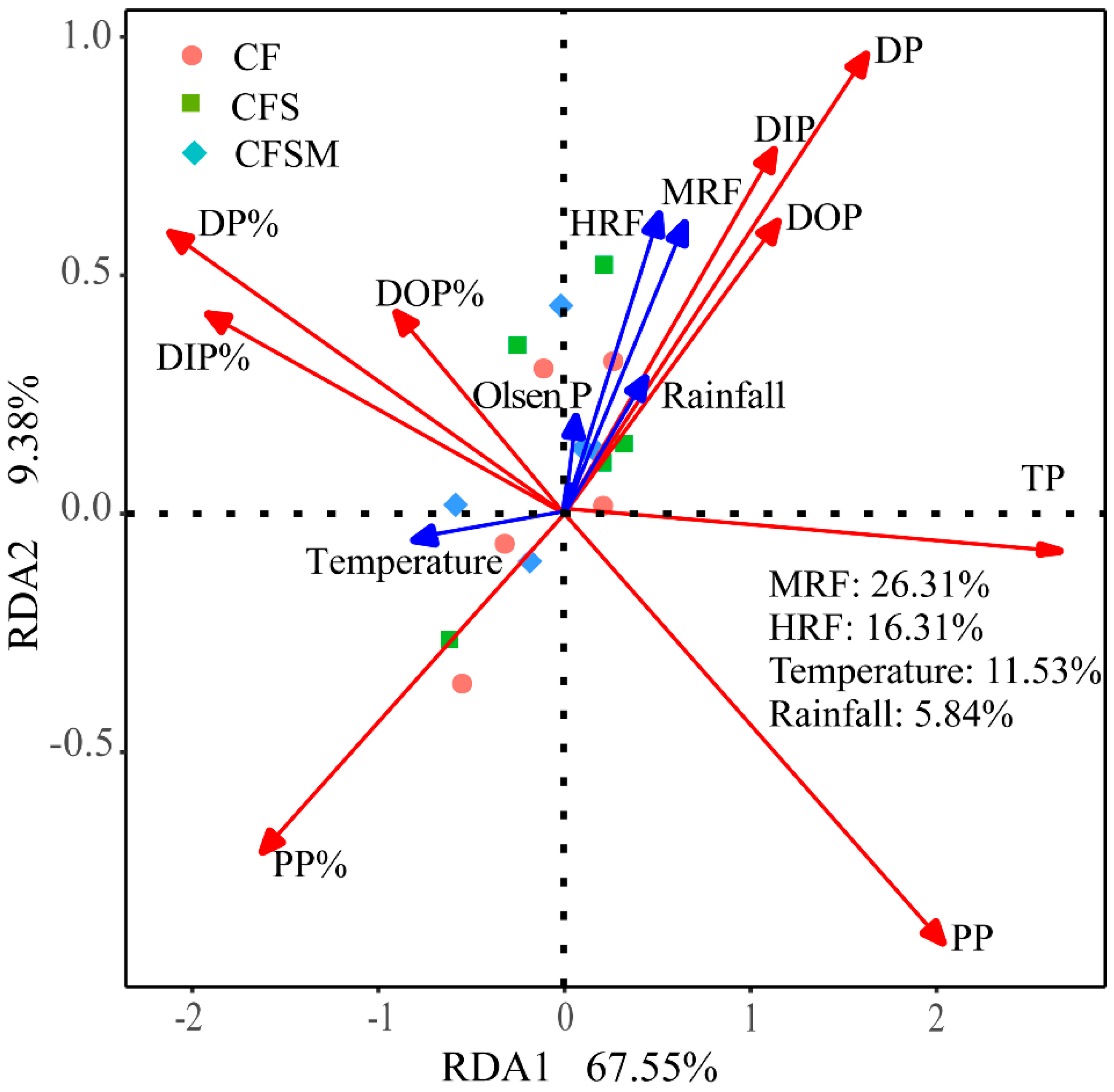
| pH | SOM g kg−1 | TN g kg−1 | TP g kg−1 | TK g kg−1 | Avail.N mg kg−1 | Avail.P mg kg−1 | San d% | Silt % | Clay % |
|---|---|---|---|---|---|---|---|---|---|
| 6.81 | 20.90 | 1.30 | 0.37 | 6.25 | 13.01 | 30.26 | 36.1 | 31.6 | 32.3 |
| Treatment | Organic Fertilizer kg ha−1 | Chemical Fertilizer kg ha−1 | Total Input kg ha−1 | ||||||
|---|---|---|---|---|---|---|---|---|---|
| N | P | K | N | P | K | N | P | K | |
| CF | 0 | 0 | 0 | 234 | 51 | 80 | 234 | 51 | 80 |
| CFS | 0 | 0 | 0 | 234 | 51 | 80 | 234 | 51 | 80 |
| CFSM | 64 | 62 | 56 | 234 | 51 | 80 | 298 | 113 | 136 |
| DIP | DOP | DP | PP | TP | |
|---|---|---|---|---|---|
| Treatment | 0.220 | 0.000 | 0.024 | 0.926 | 0.173 |
| Period | 0.001 | 0.000 | 0.001 | 0.046 | 0.010 |
| Treatment × Period | 0.002 | 0.001 | 0.002 | 0.815 | 0.039 |
| Category | Treatment | DIP | DOP | DP | PP | TP |
|---|---|---|---|---|---|---|
| Cumulative leaching loss (g ha−1) | CF | 372(28) b | 267(33) a | 639(26) b | 353(26) a | 992(60) a |
| CFS | 349(42) b | 114(19) c | 463(39) c | 326(24) a | 789(27) b | |
| CFSM | 450(63) a | 257(36) a | 707(81) a | 313(41) a | 1020(99) a | |
| Cumulative P leaching Loss relative to P input (%) | CF | 0.73(0.10) a | 0.52(0.02) a | 1.25(0.12) a | 0.69(0.03) a | 1.95(0.09) a |
| CFS | 0.68(0.02) a | 0.24(0.01) b | 1.24(0.01) a | 0.64(0.04) a | 1.54(0.06) b | |
| CFSM | 0.33(0.02) b | 0.19(0.04) b | 0.51(0.07) b | 0.23(0.05) b | 0.75(0.01) c |
Publisher’s Note: MDPI stays neutral with regard to jurisdictional claims in published maps and institutional affiliations. |
© 2022 by the authors. Licensee MDPI, Basel, Switzerland. This article is an open access article distributed under the terms and conditions of the Creative Commons Attribution (CC BY) license (https://creativecommons.org/licenses/by/4.0/).
Share and Cite
Wang, H.; Zhang, S.; Peng, C.; Chi, G.; Chen, X.; Huang, B.; Lu, C.; Li, J.; Xu, L. Quantifying Phosphorus Leaching Loss from Mollisol with Organic Amendments. Agronomy 2022, 12, 2490. https://doi.org/10.3390/agronomy12102490
Wang H, Zhang S, Peng C, Chi G, Chen X, Huang B, Lu C, Li J, Xu L. Quantifying Phosphorus Leaching Loss from Mollisol with Organic Amendments. Agronomy. 2022; 12(10):2490. https://doi.org/10.3390/agronomy12102490
Chicago/Turabian StyleWang, Hongyan, Shuxiang Zhang, Chang Peng, Guangyu Chi, Xin Chen, Bin Huang, Caiyan Lu, Jizhi Li, and Li Xu. 2022. "Quantifying Phosphorus Leaching Loss from Mollisol with Organic Amendments" Agronomy 12, no. 10: 2490. https://doi.org/10.3390/agronomy12102490




